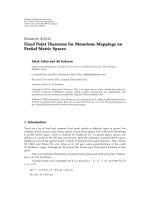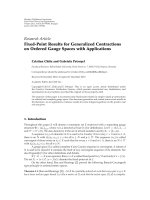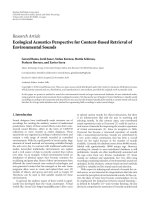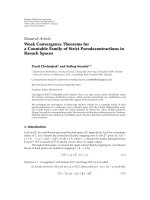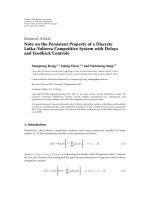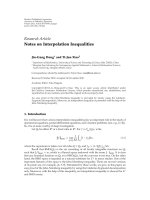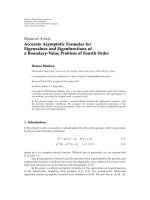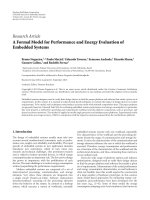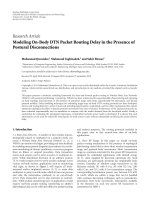Báo cáo hóa học: "Research Article Improvement on EVESPA for Beamforming and Direction of Arrival Estimation Emmanuel Racine and Dominic Grenier" doc
Bạn đang xem bản rút gọn của tài liệu. Xem và tải ngay bản đầy đủ của tài liệu tại đây (554.7 KB, 5 trang )
Hindawi Publishing Corporation
EURASIP Journal on Advances in Signal Pr ocessing
Volume 2011, Article ID 283020, 5 pages
doi:10.1155/2011/283020
Research Ar ticle
Improvement on EVESPA for Beamforming and Direction of
Arrival Estimation
Emmanuel Racine and Dominic Grenier
Department of Electrical and Computer Engineering, Laval University 1065, Avenue de la M´edecine, Qu´ebec (QC), Canada G1V 0A6
Correspondence should be addressed to Emmanuel Racine,
Received 9 September 2010; Revised 18 January 2011; Accepted 22 February 2011
Academic Editor: Laurence Mailaender
Copyright © 2011 E. Racine and D. Grenier. This is an open a ccess article distributed under the Creative Commons Attribution
License, which permits unrestricted use, distribution, and reproduction in any medium, provided the original work is properly
cited.
This paper presents an alternative estimation procedure of the generalized steering matrix of the sources in EVESPA, suitable
for both beamforming and direction of arrival estimation. It is shown how the estimation of such a matrix can be restricted to
that of its corresponding coefficient matrix in the signal subspace, providing both performance enhancement and computational
complexity reduction. Performance comparison through numerical s imulations is presented to confirm the effectiveness of the
proposed procedure.
1. Introduction
The EVESPA algorithm was introduced by G
¨
onen et al.
in [1] as an adapted version of VESPA to handle the
case of coherent signals. Using fourth-order cumulants, this
algorithm properly generates an unbiased estimation of the
generalized steering matrix (GSM) B of the sources from
which an analysis of the signal parameters can be performed
for each coherent group in an independent fashion. The
same estimation procedure is also undertaken in [2]asa
means of computing the weights of an optimal beamformer
capable of maximizing the signal-to-interference plus noise
ratio (SINR) in a coherent environment. EVESPA has also
been considered in [3] under a slight variation for t he
problem of direction of arrival (D OA) estimation in mobile
communications, and in [4] where it was adapted for a two-
dimensional scenario. Steps 1 to 7 in [2]describetheEVESPA
algorithm where the M
× G matrix B is considered in its
whole.However,sincethelatterliesinthesignalsubspace,
only the search of its corresponding G
× G coefficient matrix
proves sufficient. In this paper, we present a new estimation
procedure of B based on this principle which is shown to
bring significant performance enhancement both in terms of
computational complexity and quality estimation.
Throughout the paper, “
∗
and Ҡ
are, respectively,
used as the conjugate and Hermitian transpose operators,
and nonscalar quantities such as vectors and matrices are
labeled in bold.
2. Background Theory
In this section we recall the main guidelines of the EVESPA
algorithm [1, 2], as it will be assumed that the reader has a
sufficient knowledge on the matter. The signal model used in
this paper is the same as that used by the original authors,
namely,
x
k
= Bu
k
+ n
k
,
(1)
where x
k
, B, u
k
,andn
k
are, respectively, the M × 1vectorof
the received signals, the M
× G generalized steering matrix
of the sources, the G
× 1 elementar y sources vector, and the
M
× 1 additive white Gaussian noise (AWGN) vector, which
is assumed symmetric. Elements u
g
(t
k
), g ∈{1, 2, , G},
of u
k
are modeled as uncorrelated zero-mean random
processes, where G denotes the number of coherent groups
2 EURASIP Journal on Advances in Signal Pr ocessing
of signals impinging on the M-element array. Without loss
of generality, matrix B may be expressed as
B
= AΞ =
A
1
A
2
··· A
G
⎡
⎢
⎢
⎢
⎢
⎢
⎢
⎢
⎣
α
1
0 ··· 0
0 α
2
··· 0
.
.
.
.
.
.
.
.
.
00
··· α
G
⎤
⎥
⎥
⎥
⎥
⎥
⎥
⎥
⎦
,(2)
where A
g
and α
g
are the M × p
g
steering matrix and the
p
g
×1coefficients vector of the g-th coherent group. The total
number of sources impinging on the array is t hus
G
g
=1
p
g
.
EVESPAmaybesuitableforanytypeofsignalsprovided
that a complex envelope of interest u
g
(t
k
) admits a nonzero
fourth-order cumulant, that is,
γ
4,g
= cum
u
g
(
t
k
)
, u
∗
g
(
t
k
)
, u
g
(
t
k
)
, u
∗
g
(
t
k
)
/
= 0. (3)
The algorithm proceeds to the e valuation of the two cumu-
lant matrices:
C
m
= cum
x
m
(
t
k
)
, x
∗
1
(
t
k
)
, x
k
, x
†
k
, m ∈{1, 2},(4)
from which an estimation
B of B is obtained by following
steps 1 through 7 in [2]. Upon calculation of
B,whose
columns match those of B to within scale and permutation,
one can freely proceed to beamforming or DOA estimation
as described in [1, 2].
In the case of DOA estimation, the covariance matrix of
the g-th coherent group of signals is first estimated as
R
xx
g
=
b
g
b
†
g
,where
b
g
is the g-th column of
B. Spatial smoothing
is t hen applied to
R
xx
g
in order to estimate the DOAs of that
group. Any other DOA estimation algorithm could also be
applied once
B has been obtained from EVESPA.
In the case of beamforming, an optimum weight vector
is initially computed as w
g,opt
= c
g
R
−1
xx
b
g
,whereR
xx
is
the covariance matrix of the received signals, and where
c
g
= 1/(
b
†
g
R
−1
xx
b
g
) is a constant ensuring a unit response
in the “look” direction. This beamforming vector is then
used to recover the elementary signal u
g
(t
k
)ofthatparticular
group. Here again, any other beamforming scheme can be
implemented after estimation of B. One interesting example
is that of the null steering beamformer [5], where the array
response can be made null for all signals of a particular
group instead of synthesizing nulls for each of these signals
independently.
Note finally that although the EVESPA algorithm has
been de veloped in a context of narrowband multipath p rop-
agation, its application remains valid in any environment
provided that the received signals can be modeled as in (1),
and that the appropriate requirements on B, u
k
,andn
k
be
met. Those are essentially given by assumptions A1 through
A6 in [1], but can be summarized in a more general way as
follows.
(i) Elements u
g
(t
k
), g ∈{1, 2, , G},ofu
k
are statis-
tically independent and possess a nonzero fourth-
order c umulant.
(ii) B has G
≤ M columns linearly independent from one
another.
(iii) The fourth-order cumulant of the noise vector n
k
is
zero.
One interesting example of environment where the EVESPA
algorithm may also be applied is that of narrowband near-
field sources [6], where the signal model also finds its corre-
spondence to (1). In this paper, though, we will focus on the
description of an enhanced estimation procedure of B with
the aim of improving performance for both beamforming
and direction of arrival estimation in a coherent narrowband
scenario, since each of these subjects were covered in [1, 2].
Note however that this estimation procedure is general, and
may in fact be applied regardless of the type of subsequent
processing.
3. Proposed Estimation Procedure
Consider the covariance matrix of the received signals:
R
xx
= E
x
k
x
†
k
=
BE
u
k
u
†
k
B
†
+ E
n
k
n
†
k
≡
BR
uu
B
†
+ σ
2
n
I,
(5)
where E
{·} denotes the expected value operator. Note that
R
uu
is always diagonal since u
k
is a vector of zero-mean
and uncorrelated elements. Expressing R
xx
in terms of its
eigenvalue decomposition yields
R
xx
= E
s
Λ
s
E
†
s
+ σ
2
n
I,
(6)
where E
s
represents a set of orthonormal basis vectors of the
signal subspace. From (5)and(6), it follows that B can be
expressed in terms of E
s
such that
B
= E
s
Q,(7)
where Q is a G
× G coefficient matrix ensured to be full rank
under assumptions A1 to A4 in [2]. In the same issue, it is
also shown that matrices C
1
and C
2
of (4)evaluateto
C
1
= BΛB
†
, C
2
= BDΛB
†
,(8)
where Λ and D are both full-rank diagonal matrices. Our
alternative estimation proc edure begins by forming the two
G
×G matrices (recall from (7)thatE
†
s
B = Q,sinceE
†
s
E
s
= I)
C
1
= E
†
s
C
1
E
s
= QΛQ
†
, C
2
= E
†
s
C
2
E
s
= QDΛQ
†
,
(9)
where E
s
is obtained from the eigenvalue decomposition
(EVD) of R
xx
. We now apply an estimation procedure similar
to steps 2 through 7 in [2], but in the aim of identifying Q.
Consider for this the single value decomposition (SVD) of a
2G
× G matrix C
such that
C
=
⎡
⎣
C
1
C
2
⎤
⎦
=
⎡
⎣
Q
QD
⎤
⎦
ΛQ
†
≡ UΣV
†
, (10)
EURASIP Journal on Advances in Sig nal Processing 3
Table 1: Summary of the main computational steps involved in the
original EVESPA and the proposed estimation procedure.
Step Original EVESPA Proposed procedure
1SVDofC (2M × M)EVDofR
xx
(M × M)
2SVDof[U
11
U
12
](M × 2G)SVDofC
(2G × G)
3EVDof
−F
x
F
−1
y
(G × G)EVDofH (G × G)
4 Estimation of B Estimation of B
5
∗
EVD of R
xx
(M × M)—
6
∗
Estimation of B —
∗
: Additional steps required for the covariance based improvement method
in [1]. This improvement is applied by default in steps 1 to 4 of the
proposed procedure.
where matrix U may be partitioned into
U
=
U
s
U
n
, U
n
=
⎡
⎣
U
n
1
U
n
2
⎤
⎦
, (11)
and where U
n
1
and U
n
2
are both G × G.SincetheG last rows
of Σ are zeros, it follows that
(
C
)
†
U
n
= Q
†
U
n
1
+ D
∗
Q
†
U
n
2
= 0,
(12)
which implies that
−U
n
1
U
−1
n
2
= Q
−†
D
∗
Q
†
≡ H.
(13)
Hence, the eigenvalues of H must match the diagonal
elements of D
∗
. If t hese elements are distinct, there exists a
unique mapping between E
H
, the eigenvectors matrix of H,
and Q
−†
such that
E
H
Z
†
= Q
−†
,
(14)
where Z is a scale permutation matrix containing only
one non-zero element per line and column. Therefore, the
columns of E
−†
H
= QZ match those of Q to within scale and
permutation and a straightforward estimation of B becomes
B = E
s
Q = E
s
E
−†
H
.
(15)
4. Performance Comparison
4.1. Computational Complexity. Table 1 presents a summary
of t he main computational steps involved in both the
original EVESPA and the proposed algorithm u sing their
respective notations. It can be seen that the proposed
procedure requires only one SVD, whereas two are required
in the original EVESPA. Moreover, the only M-dependant
decomposition involved in the proposed method is that
of the initial EVD. Hence, as the number of sensors M
increases for a fixed number of coherent groups G,there
will obviously come a point where the proposed procedure
outperforms the original EVESPA in terms of computational
complexity. However, note that the final step of our proposed
method involves the inverse of the nondiagonal matrix
2 4 6 8 10 12 14 16 18 20
0
0.1
0.2
0.3
0.4
0.5
0.6
0.7
0.8
0.9
1
M
Normalized execution time
G = 2
G
= 4
G
= 8
G
= 12
Figure 1: Normalized execution time of the original EVESPA (solid
lines) and the proposed estimation procedure (dashed lines) in
terms of M and G.
E
H
, which for a minimum value of G represents a higher
complexity operation than ( 25) in [2]. Thus, the gain in
computational complexity of our proposed method does not
appear evident for low values of M. In order to appreciate
the computational complexity of each algorithm, Figure 1
displays their normalized average execution time curves for
M
∈{2, 3, ,20} and M ≥ G ∈{2,4, 8,12},where
each point was obtained from 20000 trials and randomly
generated matrices C
1
, C
2
,andR
xx
. Note that even though
the original EVESPA ( without improvement) does not make
use of R
xx
, its computation does not increase the complexity
of the proposed method since it already represents an
intermediate step in the evaluation of bot h C
1
and C
2
.
No improvement was considered for the original
EVESPA. As expected, the performance of the proposed
procedure is at its worse for low values of M and G where it is
slightly outperformed by the original EVESPA. However, this
situation quickly changes as M and G increase where the gain
in computational complexity obtained with the proposed
procedure becomes obvious. This could also have been
predicted from Tab l e 1 . All in all, the proposed estimation
procedure thus constitutes an improvement in terms of
computational complexity over the original one.
4.2. Statistical Performance. Since E
s
can be estimated from
second-order statistics, we now show that the proposed esti-
mation procedure achieves a better statistical performance
than the original EVESPA. Consider the complex angle
β
g
(K) between b
g
,theg-th column of B,and
b
g
(K), the
g-th column of
B(K) and corresponding estimation of b
g
4 EURASIP Journal on Advances in Signal Pr ocessing
Table 2: Signal parameters used for the simulation of Figure 2.
Groups θαGroups θα
1
40
◦
0.2+ j0.8
2
50
◦
0.9+ j0.3
68
◦
170
◦
1
80
◦
0.8 − j0.590
◦
0.9 − j0.3
115
◦
0.75 + j0.65 120
◦
0.8+ j0.7
130
◦
0.8 − j0.2 135
◦
0.95
3
45
◦
1
4
60
◦
0.3 − j0.8
65
◦
0.8 − j0.785
◦
0.4+ j0.9
85
◦
0.7+ j0.7 105
◦
0.8+ j0.6
110
◦
0.65 − j0.8 118
◦
0.9+ j0.7
125
◦
0.9+ j0.1 140
◦
1
obtained from K snapshots from either the original EVESPA
or the proposed algorithm. It follows that
cos
β
g
(
K
)
=
b
†
g
b
g
(
K
)
b
g
b
g
(
K
)
.
(16)
Hence, under assumptions A1 to A4 in [2]andforG
≤ M,
the MSE of this latter quantity can be computed as follow:
MSE
cos
β
g
(
K
)
=
E
1 −
cos
β
g
(
K
)
2
≡
e
g
.
(17)
Ideally,
| co s(β
g
(K))|=1 meaning that b
g
and
b
g
(K)
are collinear. Using such a performance criterion, the best
algorithm is thus the one that maximizes E
{| cos(β
g
(K))|}
for all g and a given K<∞. Taking the average of (17)over
G, a global RMSE criterion can thus be defined as
E
=
1
G
G
g=1
e
g
. (18)
Figure 2 displays the RMSE curves of both the original
EVESPA and the proposed algorithm obtained from 10000
runs of 50 snapshots for SNR values ranging from
−10 dB
to 12 dB. BPSK signals are considered using parameters of
Tabl e 2. The receiver consists of a ten-element uniform linear
array (ULA) with equal power and independent AWGN on
all elements. It can be seen that the proposed estimation
procedure achieves a better performance than the original
EVESPA for all SNRs, namely, because E
s
is estimated from
second-order statistics which possess a lower variance than
fourth-order statistics.
Note however that the use of second-or der statistics as
a means of improving the quality estimate of B was also
considered in Section 4 of [1], corresponding to steps 5 and
6ofTa bl e 1 . Upon a first estimation
B of B, a new estimation
B
was computed such that
B
= E
s
E
†
s
B.Theperformance
of such an estimator would have been similar to t hat of
the proposed estimation procedure in Figure 2.However,
the computational complexity involved in a first evaluation
Original EVESPA
Proposed procedure
0.3
0.28
0.26
0.24
0.22
0.2
0.18
−10 −50 510
SNR (dB)
^
E
Figure 2: Statistical performance comparison between the original
and the proposed estimation procedures.
of
B from the original procedure followed by an additional
EVD of R
xx
in order to compute E
s
would clearly become
higher than that of the proposed algorithm. Hence, the
latter does still represent an advantageous alternative in this
context.
5. Conclusion
In this paper, we have shown how the original EVESPA
algorithm could be improved both in terms of computational
complexity and statistical performance by restricting the
estimation of B to that of its corresponding coefficient
matrix in the signal subspace. The use of E
s
as estimated
from second-order statistics ensures a gain in statistical
performance while the reduced dimensions of C
through the
use of Q accounts for a gain in computational complexity in
a majority of scenarios.
EURASIP Journal on Advances in Sig nal Processing 5
References
[1] E. G
¨
onen,J.M.Mendel,andM.C.Dogan,“Applicationsof
cumulants to array processing—part IV: direction finding in
coherent signals case,” IEEE Transactions on Signal Processing,
vol. 45, no. 9, pp. 2265–2276, 1997.
[2] E. G
¨
onen and J. M. Mendel, “Applications of cumulants to array
processing—part III: blind beamforming for coherent signals,”
IEEE Transactions on Signal Processing, vol. 45, no. 9, pp. 2252–
2264, 1997.
[3]H.Jiang,S.X.Wang,andH.J.Lu,“Aneffective direction
estimation algorithm in multipath environment b ased on
fourth-order cyclic cumulants,” in Proceedings of the 5th IEEE
Workshop on Signal Processing Advances in Wireless Communi-
cations (SPAWC ’04), pp. 263–267, July 2004.
[4] C. Jian, S. Wang, and L. Lin, “ Two-dimensional DOA estima-
tion of coherent signals based on 2D unitary ESPRIT method,”
in Proceedings of the 8th International Conference on Signal
Processing (ICSP ’06), vol. 1, November 2006.
[5] L.C.Godara,Smart Antennas, CRC Press LLC, Boca Raton, Fla,
USA, 2004.
[6] J. Liang and D. Liu, “Passive localization of mixed near-field
and far-field sources using two-stage MUSIC algorithm,” IEEE
Transactions on Signal Processing,vol.58,no.1,ArticleID
5200332, pp. 108–120, 2010.

